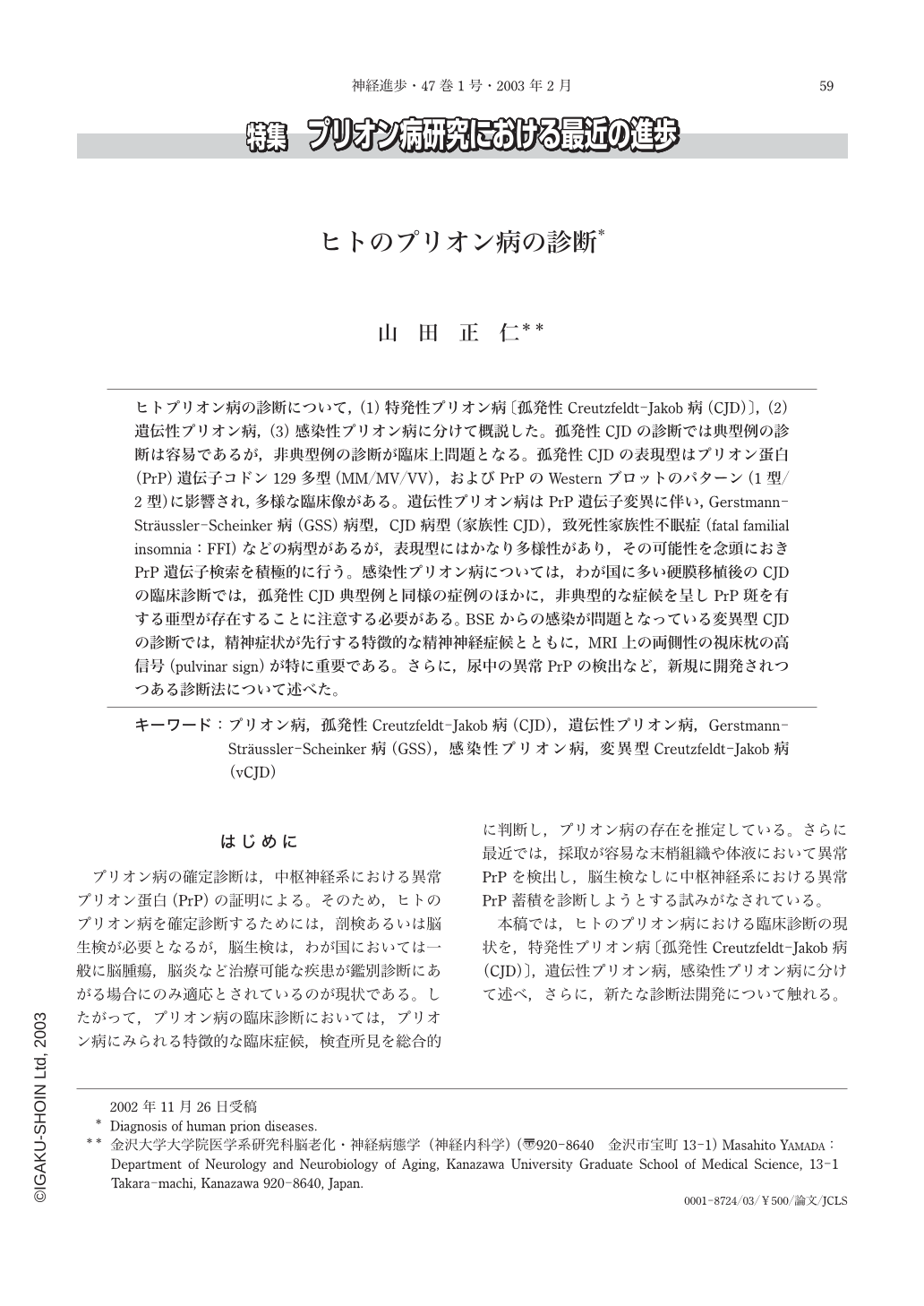Japanese
English
- 有料閲覧
- Abstract 文献概要
- 1ページ目 Look Inside
ヒトプリオン病の診断について,(1)特発性プリオン病〔孤発性Creutzfeldt-Jakob病(CJD)〕,(2)遺伝性プリオン病,(3)感染性プリオン病に分けて概説した。孤発性CJDの診断では典型例の診断は容易であるが,非典型例の診断が臨床上問題となる。孤発性CJDの表現型はプリオン蛋白(PrP)遺伝子コドン129多型(MM/MV/VV),およびPrPのWesternブロットのパターン(1型/2型)に影響され,多様な臨床像がある。遺伝性プリオン病はPrP遺伝子変異に伴い,Gerstmann-Sträussler-Scheinker病(GSS)病型,CJD病型(家族性CJD),致死性家族性不眠症(fatal familial insomnia:FFI)などの病型があるが,表現型にはかなり多様性があり,その可能性を念頭におきPrP遺伝子検索を積極的に行う。感染性プリオン病については,わが国に多い硬膜移植後のCJDの臨床診断では,孤発性CJD典型例と同様の症例のほかに,非典型的な症候を呈しPrP斑を有する亜型が存在することに注意する必要がある。BSEからの感染が問題となっている変異型CJDの診断では,精神症状が先行する特徴的な精神神経症候とともに,MRI上の両側性の視床枕の高信号(pulvinar sign)が特に重要である。さらに,尿中の異常PrPの検出など,新規に開発されつつある診断法について述べた。
はじめに
プリオン病の確定診断は,中枢神経系における異常プリオン蛋白(PrP)の証明による。そのため,ヒトのプリオン病を確定診断するためには,剖検あるいは脳生検が必要となるが,脳生検は,わが国においては一般に脳腫瘍,脳炎など治療可能な疾患が鑑別診断にあがる場合にのみ適応とされているのが現状である。したがって,プリオン病の臨床診断においては,プリオン病にみられる特徴的な臨床症候,検査所見を総合的に判断し,プリオン病の存在を推定している。さらに最近では,採取が容易な末梢組織や体液において異常PrPを検出し,脳生検なしに中枢神経系における異常PrP蓄積を診断しようとする試みがなされている。
本稿では,ヒトのプリオン病における臨床診断の現状を,特発性プリオン病〔孤発性Creutzfeldt-Jakob病(CJD)〕,遺伝性プリオン病,感染性プリオン病に分けて述べ,さらに,新たな診断法開発について触れる。
Human prion diseases are classified to(1)idiopathic(sporadic Creutzfeldt-Jakob disease(CJD)), (2)inherited, and(3)infectious forms. For sporadic CJD, phenotypic variability is present beyond typical presentation of classic CJD, which is known to be influenced by a codon 129 polymorphism of the prion protein(PrP)gene and Western blot patterns of protease-resistant PrP. Inherited prion diseases are associated with mutations of the PrP gene, presenting with Gerstmann-Sträussler-Scheinker disease(GSS), Creutzfeldt-Jakob disease(CJD)(familial CJD), and fatal familial insomnia(FFI)phenotypes. Since clinical spectrum of inherited prion diseases presents with considerable variablility, the PrP gene should be analyzed in progressive neurological disorders of unknown cause. For infectious prion diseases including dural graft-associated CJD(dCJD)and variant CJD(vCJD), it should be noted that a subgroup of dCJD cases show atypical clinical phenotype and plaque formation in the brain;in the diangosis of vCJD, the pulvinar sign on MRI is most important in addition to the characteristic clinical features. Finally, new diagnostic methods are described including detection of a protease-resistant PrP isoform in urine from patients with prion diseases.

Copyright © 2003, Igaku-Shoin Ltd. All rights reserved.


